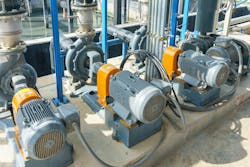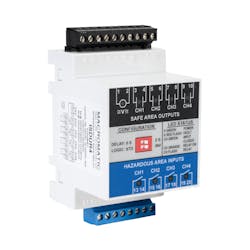Exploring options for process pump automation
Process control applications are progressively relying on digital automation to provide optimized operation, better diagnostics and enhanced data. However, sometimes there are very good reasons to integrate just the right amount of hardwired controls with these digital platforms to provide the best functionality. This can be the case for all types of process pump automation, where a variety of control and protective relays are available to provide complete hardwired automation, or close integration with other digital controls.
Tending to the workhorses
Process pumps are workhorses of many types of processing and manufacturing industries (Figure 1). They come in many physical configurations and capacities, and they may be operated at fixed or variable speeds. Some pumps are specialized for handling product in hazardous petrochemical locations or hygienic life sciences applications. Others are much more of a commodity and simply pump utility or sump water.
It is common to drive process pumps with electrical motors and three-phase power. Here are some typical functional and protective features needed for industrial process pumps:
- Alternating operation
- Seal failure monitoring
- Electrical monitoring
- Intrinsically safe signaling
For smaller and simpler hardwired systems, it is common to use specialized electrical relays to perform some or all of these functions. Even for larger systems or those employing programmable logic controllers (PLCs) or other digital controllers, there are many reasons to incorporate mission-specific relays for these purposes.
Alternating relays
Many processes employ two pumps for redundancy — only one pump needs to run at any given time, and it does not matter which one it is, but it is important that a second pump be available to operate if the first one fails. This is typical functionality for pumping liquids out of tanks or sumps on an intermittent basis. However, it usually is not desirable to only run one pump as needed while keeping the other in reserve.
An alternating relay is a basic device that takes a signal start command from any hardwired or digital logic and alternately starts one load or the other, helping to equalize runtime between the pumps. The relay may also have indicating lights and a switch so users can override operation to only one of the pumps, making it easier for them to service the second pump.
Seal failure relays
Some types of pumps are submersed into a sump instead of being installed on the outside of a vessel. While this is a convenient installation method and can serve to cool the pumping equipment, it also makes the electrical motor susceptible to water intrusion from leaks.
A seal failure relay works with standard resistive shaft seal leak sensors, and it is easily adjustable to match the sensor type. When the monitored sensor detects water, the relay actuates to indicate the fault. Designers can simply trigger an alarm based on this, or they can perform more elaborate operations, such as stopping the faulted pump and starting another.
Phase-monitoring relays
Three-phase electrical motors used for pump service can experience several types of faults. If a single upstream fuse blows, or if one of the motor windings fails, the motor may continue to operate in a single-phase mode, which is not desirable. Other electrical problems include phase reversal, phase unbalance, undervoltage and overvoltage. Each of these is a sign of electrical system issues, which will likely result in undesirable operation, often leading to larger problems.
A basic phase-monitoring relay may be used to detect some of these issues, while more advanced microprocessor-based versions can detect all these issues (Figure 2). As with seal failure relays, it is good practice to incorporate phase-monitoring relays with automation system designs to alarm and usually stop equipment experiencing electrical problems.
Intrinsically safe signaling
One approach is to use single- or multi-channel intrinsically safe relays to permit signaling but act as an energy barrier, limiting the amount of voltage and current available in the hazardous area and protecting against ignition. Intrinsically safe relays allow electrical contacts, switches or sensors in hazardous areas to be monitored safely by automation located outside the hazardous area (Figure 3).
Pump application benefits
Pump control and monitoring relays are convenient for many reasons. Among the most important features they provide is a local method for maintenance personal to check the functional status of the equipment and perform any troubleshooting necessary.
These types of relays minimize downtime by equalizing equipment runtime or by providing early detection of any potential problems. This early warning is critical so users can respond before operational issues escalate. Or, control systems can use the fault information to make intelligent operating decisions and keep processes running.
Digital phase monitor relays, in particular, provide important benefits because they can detect so many possible electrical issues; some of which may not cause immediate shutdowns but can clearly indicate a larger problem may be developing. These relays will provide a single trouble signal to the supervisory control system, while using pulsing indicator lights to locally identify the type of trouble.
For original equipment manufacturers (OEMs), pump relays provide a convenient way for them to standardize the designs of their control panels. Furthermore, when these OEMs find it necessary to offer various options or makes/models of automation systems for their pump equipment, these control and monitoring relays can provide consistency and simplify the interface to any type of automation system.
For instance, an OEM can offer their pumps with standard interface control panels preconfigured with the appropriate relays. End users can apply whatever supervisory controls make sense for the process and their operating standards. Maintenance personnel and OEM service technicians will all be familiar with the common relay designs when they are servicing the pumps, regardless of the automation platform.
Enhanced process pump protection
Control and monitoring relays are available in many styles to provide improved pump functionality and to monitor leaks and electrical characteristics. These relays are an economical way to provide a consistent interface with electrically driven pumps, which in turn can be operated by any type of hardwired or digital controls. In addition, these relays are a straightforward way to provide local indication and troubleshooting features for maintenance personnel. Providing the right combination of relays for pump control applications improves designs, leading to simpler operations and maintenance.
Lenny Filipkowski is a product manager at AutomationDirect. He began his career as an electrical engineer and has more than 28 years of experience working with industrial equipment and controls for the manufacturing, steel, water/wastewater treatment, pulp and paper, non-woven industry and conveying industries. Filipkowski leverages this experience to connect AutomationDirect customers with the right products and solutions for their applications.
About the Author
Lenny FilipkowskI
Lenny Filipkowski is a product manager at AutomationDirect. He began his career as an electrical engineer and has more than 28 years of experience working with industrial equipment and controls for the manufacturing, steel, water/wastewater treatment, pulp and paper, non-woven industry and conveying industries. Filipkowski leverages this experience to connect AutomationDirect customers with the right products and solutions for their applications.



